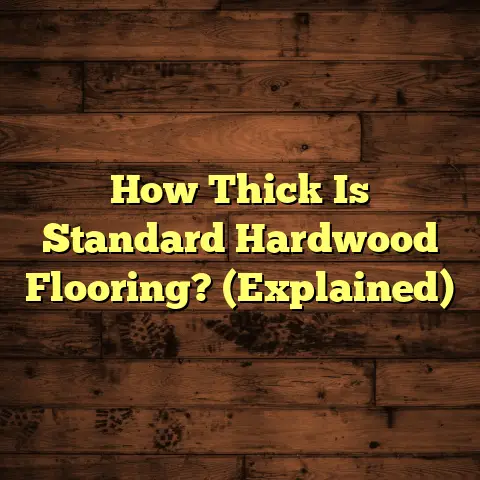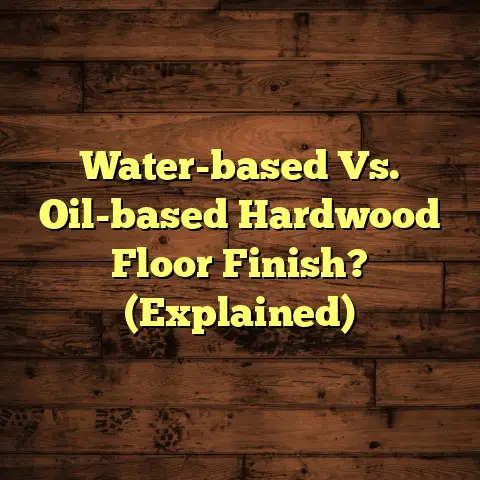What Makes Vinyl Floors Shine? (Secret Trick!)
Ever tried to impress guests with your sparkling clean floors, only to have them nearly wipe out the second they step inside?
I’ve been there, and believe me, it’s not a good look.
We’ve all been there, trying to get that perfect shine, only to end up with a slippery disaster.
Let’s face it: we all want our homes to look their best, and that often starts from the ground up.
A gleaming floor reflects cleanliness, care, and a certain je ne sais quoi that makes a house feel like a home.
So, what’s the secret to achieving that coveted shine
on your vinyl floors?
I’m going to let you in on a little
trick I’ve learned over years in the flooring biz.
Trust me, by the end of this article, you’ll be armed with the knowledge to transform your dull floors into a show-stopping centerpiece!
Section 1: Understanding Vinyl Flooring
What is Vinyl Flooring?
Vinyl flooring has come a long way since its humble
beginnings.
Back in the day, it was often seen as a
cheap alternative to more luxurious materials.
But today, it’s a popular choice for homeowners and businesses alike, thanks to its durability, cost-effectiveness, and incredible design versatility.
A Brief History:
Believe it or not, the first form of vinyl flooring dates back to the late 19th century!
However, it wasn’t until the 1930s that modern vinyl flooring really took off, with advancements in manufacturing processes.
Over the decades, it has evolved from simple, basic designs to incredibly realistic imitations of wood, stone, and tile.
Different Types of Vinyl:
There are three main types of vinyl flooring you’ll encounter: sheet vinyl, vinyl plank, and vinyl tile.
-
Sheet Vinyl: This comes in large rolls, often 12 feet wide, which means fewer seams and a more water-resistant surface.
I often recommend this for bathrooms and kitchens.
Vinyl Plank: These are individual strips that click together, mimicking the look of hardwood.
It’s easier to install than sheet vinyl.-
Vinyl Tile: Similar to plank, but in square or rectangular shapes, resembling ceramic or stone tiles.
It offers great design flexibility.
Advantages of Vinyl:
- Durability: Vinyl is tough.
It can withstand heavy foot traffic, spills, and everyday wear and tear. - Cost-Effectiveness: Compared to hardwood or stone, vinyl is much more budget-friendly.
- Design Versatility: The options are endless!
You can find vinyl that looks like almost any other flooring material.
Why Do We Want Our Vinyl Floors to Shine?
Let’s be honest: nobody wants dull, lifeless floors.
A shiny floor isn’t just about aesthetics; it’s about creating a feeling of cleanliness and well-being.
Psychological and Aesthetic Benefits:
A shiny floor can brighten up a room, making it feel more spacious and inviting.
It also reflects light, which can enhance the overall ambiance of your home.
Psychologically, a clean, shiny floor can give you a sense of accomplishment and pride in your living space.
The Role of Shine in Home Value:
I’ve seen firsthand how well-maintained floors can impact a home’s value.
Potential buyers are always impressed by a house that looks clean and cared for, and shiny floors definitely contribute to that impression.
Section 2: The Science of Shine
How Vinyl Floors Get Their Shine
Ever wondered what makes some vinyl floors shine more
than others?
It’s all about the composition of the vinyl
and the finishing processes used during manufacturing.
Vinyl Composition and Light Interaction:
Vinyl flooring is typically made from layers of PVC (polyvinyl chloride) and other materials.
The top layer, known as the wear layer, is crucial for both durability and shine.
This layer is often treated with a special coating, such as urethane or enhanced urethane, which helps to protect the floor from scratches and scuffs, while also enhancing its reflective properties.
When light hits the surface, it bounces back, creating that desirable shine.
Finishing Processes:
During manufacturing, vinyl floors undergo various finishing processes to enhance their shine.
These processes can include:
- Applying a protective coating: As mentioned, urethane or enhanced urethane coatings are common.
- Buffing: This process smooths out the surface and increases its reflectivity.
- Embossing: While not directly related to shine, embossing can create textures that enhance the overall look of the floor.
Common Misconceptions About Shine
There are a lot of myths and misconceptions floating
around about how to achieve and maintain shine on
vinyl floors.
Let’s debunk a few of them:
Myth 1: All Cleaning Agents are Created Equal:
- Reality: Nope!
Some cleaning agents can actually dull your floors over time.
Harsh chemicals, abrasive scrubbers, and even certain types of soap can strip away the protective coating, leaving your floors looking lackluster.
Myth 2: More is Always Better:
- Reality: Over-cleaning can be just as bad as
under-cleaning.
Using too much cleaning solution can leave a residue that attracts dirt and grime, ultimately dulling the shine.
Myth 3: Gloss and Shine are the Same Thing:
- Reality: While the terms are often used
interchangeably, there’s a subtle difference.
Gloss refers to the level of reflectivity of a surface, while shine is more about the overall appearance of cleanliness and polish.
You can have a high-gloss floor that still looks dull if it’s covered in dirt and grime.
Section 3: Everyday Factors Affecting Shine
Environmental Influences
Your environment plays a significant role in how your vinyl floors look and how long they maintain their shine.
Sunlight Exposure:
The Impact: Prolonged exposure to direct sunlight can cause vinyl floors to fade and discolor over time.
The UV rays can break down the materials in the flooring, leading to a loss of shine and vibrancy.-
My Recommendation: Use curtains, blinds, or window film to filter out harsh sunlight, especially during peak hours.
Humidity:
The Impact: While vinyl is generally water-resistant, extreme humidity can still affect its appearance.
High humidity can cause moisture to seep into the edges and seams of the flooring, leading to warping and discoloration.-
My Recommendation: Ensure proper ventilation in bathrooms and kitchens, and consider using a dehumidifier in areas prone to high humidity.
Foot Traffic:
The Impact: Foot traffic is a major culprit when it comes to dulling vinyl floors.
Every step grinds dirt, dust, and other particles into the surface, scratching and scuffing the protective coating.My Recommendation: Place mats at entrances to trap dirt and debris before they get tracked onto your floors.
Regularly sweep or vacuum to remove loose particles.
Cleaning Habits
How you clean your vinyl floors can make or break their shine.
Common Cleaning Mistakes:
- Using the Wrong Cleaning Products: As I mentioned earlier, harsh chemicals and abrasive cleaners can damage the protective coating on vinyl floors.
- Over-Wetting the Floors: Too much water can seep into the seams and edges of the flooring, leading to warping and discoloration.
- Not Rinsing Properly: Leaving cleaning solution residue on the floor can attract dirt and grime, dulling the shine.
The Role of Dirt and Grime:
Dirt and grime act like tiny sandpaper particles, scratching and dulling the surface of your vinyl floors with every step.
Regular cleaning is essential to remove these particles and maintain the shine.
Section 4: The Secret Trick Revealed
Alright, folks, the moment you’ve been waiting for!
I’m about to reveal the secret trick that will transform
your dull vinyl floors into a dazzling spectacle.
Unveiling the Secret Trick:
The secret? It’s not just about what you use, but how you use it.
My go-to method involves a combination of gentle cleaning and a surprising ingredient: white vinegar.
Yes, you read that right!
White vinegar is a natural,
non-toxic cleaner that can effectively remove dirt,
grime, and even stubborn stains without damaging your
vinyl floors.
The acidity of the vinegar helps to break down the buildup of soap residue and other impurities, leaving your floors looking clean and shiny.
Step-by-Step Guide:
-
Gather Your Supplies:
- A bucket
- Warm water
- White vinegar
- A microfiber mop
- A clean, dry towel
-
Prepare the Cleaning Solution:
- Mix one cup of white vinegar with one gallon of warm water in the bucket.
-
Mop the Floors:
- Dip the microfiber mop into the cleaning solution, wring it out thoroughly, and mop the floors in sections.
Rinse (Optional):
- If you’re concerned about the vinegar smell, you
can rinse the floors with clean water after mopping.
However, I find that the smell dissipates quickly.
- If you’re concerned about the vinegar smell, you
can rinse the floors with clean water after mopping.
Dry the Floors:
- Use a clean, dry towel to dry the floors thoroughly.
This will prevent water spots and streaks, leaving your floors looking their best.
- Use a clean, dry towel to dry the floors thoroughly.
Why This Works:
The white vinegar helps to cut through grime and residue without leaving a film.
The microfiber mop is gentle on the vinyl and effectively removes dirt without scratching the surface.
Drying the floors prevents water spots and ensures a streak-free shine.
Important Note: Always test the cleaning solution in an inconspicuous area first to ensure it doesn’t damage the flooring.
Real-Life Testimonials:
Don’t just take my word for it!
Here are a few
testimonials from people who have successfully used
this trick:
- “I was skeptical at first, but the white vinegar
trick really works!
My floors look cleaner and shinier than they have in years.” – Sarah M. - “I’ve tried so many different cleaning products,
but nothing compares to the results I get with
white vinegar.
It’s amazing!” – John B. - “I have kids and pets, so my floors take a beating.
The white vinegar trick helps me keep them looking their best without using harsh chemicals.” – Lisa K.
Section 5: Maintenance Tips for Long-Lasting Shine
Now that you know the secret trick, let’s talk about how to maintain that shine for the long haul.
Regular Cleaning Routines:
- Sweep or Vacuum Regularly: Aim to sweep or vacuum your vinyl floors at least once a week to remove loose dirt and debris.
- Mop as Needed: Mop your floors with the white vinegar solution every one to two weeks, or more often if needed.
- Spot Clean Spills Immediately: Don’t let spills
sit on your floors for too long.
Clean them up immediately to prevent staining and damage.
The Right Tools and Products:
- Microfiber Mop: As I mentioned, a microfiber mop is gentle on vinyl floors and effectively removes dirt.
- White Vinegar: This is my go-to cleaning solution for its effectiveness and non-toxic properties.
- Doormats: Place doormats at entrances to trap dirt and debris before they get tracked onto your floors.
- Furniture Pads: Use furniture pads under the legs of your furniture to prevent scratches and scuffs.
Preventative Measures:
- Avoid Harsh Chemicals: Steer clear of harsh chemicals, abrasive cleaners, and scouring pads, as they can damage the protective coating on vinyl floors.
- Trim Pet Nails: Keep your pet’s nails trimmed to prevent them from scratching the floors.
- Be Careful with High Heels: High heels can dent and scratch vinyl floors, so be mindful when wearing them indoors.
Section 6: When to Seek Professional Help
While the white vinegar trick and regular maintenance can go a long way in keeping your vinyl floors shiny, there are times when you may need to call in the pros.
Signs Your Floors Need Professional Attention:
- Deep Scratches: If your floors have deep scratches that you can’t remove with DIY methods, a professional floor refinisher may be able to help.
- Discoloration: Stubborn stains or discoloration that won’t budge with regular cleaning may require professional treatment.
- Warping or Buckling: If your floors are warping or buckling, it could be a sign of moisture damage that needs to be addressed by a professional.
- Extensive Damage: If your floors have suffered extensive damage, such as from a flood or fire, it may be best to replace them altogether.
Choosing a Professional Service:
- Do Your Research: Read online reviews and ask for recommendations from friends and family.
- Get Multiple Quotes: Compare prices and services from different companies before making a decision.
- Ask About Experience: Choose a company with experience in vinyl floor maintenance and repair.
- Check for Insurance and Licensing: Make sure the company is properly insured and licensed to protect yourself from liability.
Conclusion
So, there you have it!
The secret trick to achieving
shiny vinyl floors is a combination of gentle cleaning
with white vinegar and regular maintenance.
By following these tips, you can keep your floors looking their best for years to come.
And who knows, maybe your shiny floors will even impress your guests or prevent your pets from slipping and sliding across the living room!
Happy cleaning!





